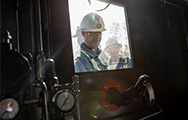Climate change and energy transition
We fully support the Paris Agreement’s goal to keep the rise in global average temperature this century to well below two degrees Celsius (2°C) above pre-industrial levels and to pursue efforts to limit the temperature increase even further to 1.5°C.
We are taking action to tackle our own emissions and to help customers to reduce theirs. As the energy system evolves, so will our business to provide the mix of products that our customers need.
We believe more renewable energy such as solar and wind is critical for a cleaner energy future, and that how people live, work and play is increasingly going to need to be powered by low-carbon electricity. But we expect that consumers will continue to use oil and gas for some time to come and not all economic activities can be easily, swiftly or cost-effectively electrified. We see continuing, changing roles for oil and gas alongside renewable energy, hydrogen and new technologies.
We are growing our New Energies business with investments in low-carbon technologies, including biofuels, electric vehicle charging and wind power. We are also developing complementary approaches like carbon capture and storage and nature-based solutions to manage the difficult-to-avoid emissions that will remain in the system for years to come due to continued consumer use of oil and gas.
Addressing a challenge as big as climate change requires a collaborative, society-wide approach. We believe that smart policies from governments, such as applying a cost to emissions through measures such as carbon-pricing mechanisms, supported by effective steps to reduce emissions from businesses including ours and from wider society, are the best ways to reach solutions and drive progress.

Today, change is being driven by a growing global population, a rising urban population and increasing prosperity.
External voice

Jim Skea
Professor of Sustainable Energy, Centre for Environmental Policy, Imperial College London
“Shell has long provided leadership in preparing global energy scenarios.
“Our team at Imperial College London has been trying to understand the differences – and similarities – between the Intergovernmental Panel on Climate Change’s scenarios underpinning the Paris Agreement and those produced by the International Energy Agency, Shell and other energy companies.
“This helps us understand how the gap between long-term climate ambitions and shorter-term energy trends can be bridged. Shell has helped us in this task, first through the Sky scenario, which aims to be compatible with the Paris goal, and second by publishing detailed assumptions and model outputs.
“This unequalled degree of transparency really helps us hone in on what matters, and can underpin the dialogue across sectors that is urgently needed. Our team was very pleased by Shell’s willingness to interpret and explain their scenario work.”
Working together to lower emissions
We continue to work with others to find ways to lower emissions, both ours and society’s more generally. We are a founding member of the Energy Transitions Commission, which brings together leaders representing a wide range of sectors and interests. The commission aims to accelerate change towards low-carbon energy systems that enable robust economic development and limit the rise in global average temperature this century to well below 2°C above pre-industrial levels.
We work with the Oil and Gas Climate Initiative (OGCI), a voluntary CEO-led group that focuses on carbon capture, utilisation and storage (CCUS), methane detection and reduction, as well as energy efficiency.
In 2019, the OGCI launched an initiative to unlock large-scale investment in CCUS, with an early aspiration to double the amount of carbon dioxide that is currently stored globally before 2030. The initiative aims to decarbonise industrial hubs around the world, starting in China, Norway, the Netherlands, the UK and the USA.
We are also members of the Hydrogen Council, a group comprising CEOs working to raise the profile of hydrogen’s role in the transition to a low-carbon energy system.
In 2019, we published our first Industry Associations Climate Review, which assesses our alignment with 19 selected, key industry associations on climate-related policy. Read more about our work with industry associations at www.shell.com/public-advocacy-and-political-activity.
We have announced support for various country climate initiatives, including the direct regulation of methane in the USA, net-zero emissions in the UK by 2050; and the climate accord in the Netherlands. We also support the European Commission’s proposal for the EU to achieve net-zero emissions by 2050. Visit www.shell.com/public-advocacy-and-political-activity for more on advocacy.
Climate change management organogram
[A] Oversight of climate change risk management.
[B] Non-executive Directors appointed by the Board to review and advise on sustainability policies and practices including climate change.
[C] Non-executive Directors appointed by the Board to oversee the effectiveness of the system of risk management and internal control.
[D] Non-executive Directors appointed by the Board to set the remuneration policy in alignment with strategy.
[E] Responsible for implementing Shell’s GHG strategy. They are represented in the Safety and Environment Leadership Team.
Decarbonising energy use by sector
We also helped to develop a range of sector-specific programmes under the Mission Possible Platform, a collaborative initiative by the World Economic Forum in partnership with the Energy Transitions Commission. The platform focuses on developing partnerships for enabling the heavy industry and heavy-duty transport sectors to achieve net-zero carbon emissions.
For example, we joined the Global Maritime Forum’s Getting to Zero shipping coalition announced at the UN Climate Summit in New York in 2019. The coalition brings together more than 90 companies from a range of backgrounds, including maritime, energy and finance, to engineer clean fuels and vessels while pushing to ensure these are supported by adequate infrastructure, such as ports. The coalition aims to find a way to put a commercially viable net-zero emissions ship to sea by 2030.
 Climate change
Climate change
 Sustainable development goals
Sustainable development goals
 Safety
Safety
 About our data
About our data

